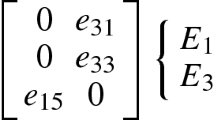Summary
The plane strain problem for an interface crack between two bonded piezoelectric semi-infinite planes under remote electromechanical loading is considered. Mechanically frictionless and electrically permeable contact zones are assumed at the crack tips and the remaining part of the crack is considered as electrically limited permeable with a certain permeability of the crack medium. Patron’s way of modelling limited permeable conditions is used. By means of integral transforms the problem is reduced to a nonlinear system of singular integral equations. An iterative scheme together with discretization and utilization of Gauss-Chebishev quadrature rule is applied for the solution of this system. Distributions of the electric displacement along the crack region as well as the stress and electric intensity factors and the energy release rate are found for different electromechanical loads and crack permeabilities. Calculations are performed for an artificial contact zone length, however the way of an easier determination of the associated values for the real contact zone length is shown. As a particular case of the obtained solution the crack in a homogeneous piezoelectric media is considered. The results of the calculations are compared to the corresponding results obtained earlier by means of Hao and Shen’s way of modelling the crack permeability. Even though the electric displacements obtained in the respective framework of these models differ essentially, it appears that the fracture mechanical parameters are in good agreement with each other.
Similar content being viewed by others
References
Suo, Z., Kuo, C. M., Barnet, D. M., Willis, J. R.: Fracture mechanics for piezoelectric ceramics. J. Mech. Phys. Solids 40, 739–765 (1992).
Parton, V. Z.: Fracture mechanics of piezoelectric materials. Acta Astronaut. 3, 671–683 (1976).
Pak, Y. E.: Linear electro-elastic fracture mechanics of piezoelectric materials. Int. J. Franc. 54, 79–100 (1992).
Sosa, H.: On the fracture mechanics of piezoelectric solids. Int. J. Solids Struct. 29, 2613–2622 (1992).
Deeg, W. F.: The analysis of dislocation, crack, and inclusion problems in piezoelectric solids. PhD thesis, Stanford University, 1980.
Parton, V. Z., Kudryavtsev, B. A.: Electromagnetoelasticity. New York: Gordon and Breach 1998.
Hao, T. H., Shen, Z. Y.: A new electric boundary condition of electric fracture mechanics and its applications. Engng. Fract. Mech. 47, 793–802 (1994).
McMeeking, R. M.: Crack tip energy release rate for a piezoelectric compact tension specimen. Engng. Fract. Mech. 64, 217–244 (1999).
Balke, H., Kemmer, G., Drescher, J.: Some remarks on fracture mechanics of piezoelectric solids. In: Proc. Micro Materials Conf. Micro Mat’97 (Michel, B., Winkler, T., eds.), pp. 398–401. Berlin 1997.
Fulton, C. C., Gao, H.: Effect of local polarization switching on piezoelectric fracture. J. Mech. Phys. Solids 49, 927–952 (2001).
Hao, T. H.: Periodical collinear air containing cracks in a piezoelectric material. Int. J. Fract. 112, 197–204 (2001).
Hao, T. H.: Multiple collinear cracks in a piezolelectric material. Int. J. Solids Struct. 38, 9201–9208 (2001).
Zhang, T.-Y., Zhao, M., Tong, P.: Fracture of piezoelectric ceramics. Adv. Appl. Mech. 38, 147–289 (2002).
Gruebner, O., Kamlah, M., Munz D.: Finite element analysis of cracks in piezoelectric materials taking into account the permittivity of the crack medium. Engng. Fract. Mech. 70, 1399–1413 (2003).
Dascalu, C., Homentcovschi, D.: An intermediate crack model for flaws in piezoelectric solids. Acta Mech. 154, 85–100 (2002).
Comninou, M.: The interface crack. J. Appl. Mech. 44, 631–636 (1997).
Govorukha, V. B., Loboda, V. V.: Contact zone models for an interface crack in a piezoelectric material. Acta Mech. 140, 233–246 (2000).
Govorukha, V., Kamlah, M., Munz, D.: The interface crack problem for piezoelectric semi-interface strip under concentrated electromechanical loading. Engng. Fract. Mech. 71, 1853–1871 (2004).
Govorukha, V. B., Munz, D., Kamlah, M.: On the singular integral equations approach to the interface crack problem for piezoelectric materials. Arch. Mech. 52, 247–273 (2000).
Erdogan, F., Gupta, G. D.: On the numerical solution of a singular integral equations. Quart. Appl. Math. 29, 525–534 (1972).
Prudnikov, A. P., Brichkov, V. A., Marichev, O. I.: Integrals and rows, vol. 1. Moscow: Nauka 1981.
Muskhelisvili, N. I.: Singular integral equations. Noordhoff: Groningen 1953.
Park, S., Sun, C. T.: Fracture criteria for piezoelectric ceramics. J. Am. Ceram. Soc. 78, 1475–1480 (1995).
Dunn, M. L., Taya, M.: Electroelastic field concentrations in and around inhomogeneities in piezoelectric solids. J. Appl. Mech. 61, 474–475 (1994).
Loboda, V. V.: Analytical derivation and investigation of the interface crack models. Int. J. Solids Struct. 35, 4477–4489 (1998).
Author information
Authors and Affiliations
Corresponding author
Rights and permissions
About this article
Cite this article
Govorukha, V., Kamlah, M. Investigation of an interface crack with a contact zone in a piezoelectric bimaterial under limited permeable electric boundary conditions. Acta Mechanica 178, 85–99 (2005). https://doi.org/10.1007/s00707-005-0214-6
Received:
Revised:
Published:
Issue Date:
DOI: https://doi.org/10.1007/s00707-005-0214-6



